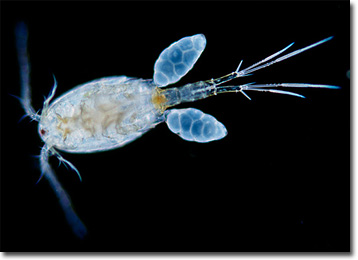Wim van Egmond
Copepod
Copepods are a class of crustaceans whose members are generally quite small, usually only achieving lengths that range between 0.5 to 2 millimeters. Some copepods, however, are significantly larger, such as Penella balaenoptera, a parasite of the finback whale that may grow up to 32 centimeters long.

Approximately 10,000 species of copepods have been identified and the group of organisms exhibits a substantial amount of variation. Though they all lack the compound eyes and carapaces characteristic of most other crustaceans, copepods exist in a multiplicity of forms and may inhabit freshwater and seawater, as well as the moisture between grains of sand or soil and the body tissues of fish and other aquatic organisms. Reproduction of copepods is also diverse, but is typically sexual. Significant sexual dimorphism may be present, especially among parasitic forms. In one species, for instance, the male is so tiny that he inhabits a small pouch in the genital tract of the female.
Copepods feed upon an array of microscopic organisms and some species prey upon creatures as large as themselves. Their first pair of trunk limbs, called the maxillipeds, plays a central role in the process of food collection. These structures are followed by four pairs of swimming legs and sometimes a fifth pair of greatly modified legs utilized for reproductive purposes. Through the use of the swimming legs and beating antennae, free-swimming copepods may move easily about their environments. When present in lakes or deep ponds, the organisms often travel from location to location in a periodic cycle of vertical migrations.
BACK TO WIM VAN EGMOND GALLERY
